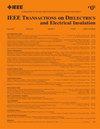Insulation Failure Mechanism of Polyimide Under High-Frequency Electrical Stress: A Synergistic Analysis of Aging Experiments and Molecular Dynamics Simulations
IF 3.1
3区 工程技术
Q2 ENGINEERING, ELECTRICAL & ELECTRONIC
IEEE Transactions on Dielectrics and Electrical Insulation
Pub Date : 2024-11-01
DOI:10.1109/TDEI.2024.3489602
引用次数: 0
Abstract
Polyimide (PI), an insulating material extensively employed in high-frequency power transformers, encounters accelerated insulation deterioration under high-frequency electrical stress. This study elucidates the insulation failure process of PI under high-frequency electrical stress by employing a combined approach of aging experiments and reactive force field molecular dynamics (ReaxFF MDs) simulation, with scanning electron microscopy (SEM) analysis and Fourier transform infrared spectroscopy (FTIR) used. The investigation reveals that the primary causes of PI insulation failure are partial discharge (PD) erosion and electrothermal aging. PD progressively erodes the PI surface, with the erosion intensity initially intensifying before diminishing over the material’s lifespan. The synergistic impact of electrothermal stress instigates the fracture of various chemical bonds within PI molecules. These include the C-H and C-N bonds in the imide ring and C-C bonds connecting the imide structure to the benzene ring, leading to the generation of gaseous byproducts like CO and H2 O. Concurrently, the rupture of the C-O–C bond between the benzene ring and the disintegration of the imine ring result in the main chain’s fragmentation. This process leads to the continual degradation and recombination of molecular chains with varying polymerization degrees and a small hydrocarbon product C2 H2 is produced. The influence of electrical stress on PI’s molecular configuration manifests in the alteration of the electric dipole moment and the elongation of polar bonds, notably the C-N bond in the imine ring, which rapidly fractures under electric heating stress.高频电应力下聚酰亚胺绝缘失效机理:老化实验与分子动力学模拟的协同分析
聚酰亚胺(PI)是一种广泛应用于高频电力变压器的绝缘材料,在高频电应力作用下,其绝缘性能会加速劣化。本研究采用老化实验和反作用力场分子动力学(ReaxFF MDs)模拟相结合的方法,结合扫描电镜(SEM)分析和傅里叶变换红外光谱(FTIR)分析,阐明了高频电应力下PI的绝缘失效过程。研究表明,局部放电侵蚀和电热老化是导致PI绝缘失效的主要原因。PD逐渐侵蚀PI表面,侵蚀强度最初增强,然后在材料的使用寿命期间减弱。电热应力的协同作用引发了PI分子内各种化学键的断裂。其中包括亚胺环上的C-H键和C-N键,以及连接亚胺结构与苯环的C-C键,产生CO和H2 o等气态副产物。同时,苯环之间的C-O-C键断裂,亚胺环解体,导致主链断裂。这一过程导致不同聚合度的分子链不断降解和重组,产生小的烃产物C2 H2。电应力对PI分子构型的影响表现为电偶极矩的改变和极性键的伸长,特别是亚胺环中的C-N键在电加热应力作用下迅速断裂。
本文章由计算机程序翻译,如有差异,请以英文原文为准。
求助全文
约1分钟内获得全文
求助全文
来源期刊
CiteScore
6.00
自引率
22.60%
发文量
309
审稿时长
5.2 months
期刊介绍:
Topics that are concerned with dielectric phenomena and measurements, with development and characterization of gaseous, vacuum, liquid and solid electrical insulating materials and systems; and with utilization of these materials in circuits and systems under condition of use.

 求助内容:
求助内容: 应助结果提醒方式:
应助结果提醒方式:


